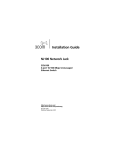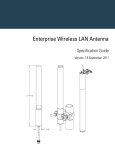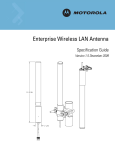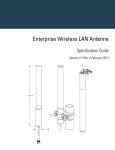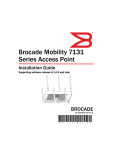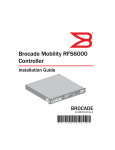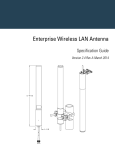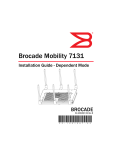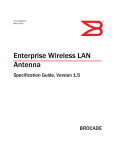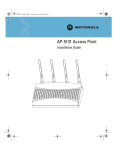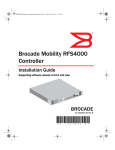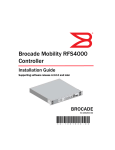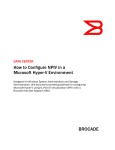Download Brocade Communications Systems 300 Installation guide
Transcript
Introduction Lock port The lock port, compatible with laptop-style security cables, is on the side of the case. 235mm (9.25in.) 146mm (5.75in.) 25.4mm (1.0in.) 0.73kg (1.6lbs) Quick Installation Guide Length Width Height Weight Motherboard firmware enables the unit to boot after either a power up or a watchdog reset. After self-boot, the motherboard sends an “I am alive” message into the network to be adopted and loaded with the actual runtime code. The boot firmware on the motherboard and the firmware downloaded from the switch can be updated using the Ethernet interface from the Wireless Controller. Radio characteristics The Mobility 300 is an IEEE 802.11-compliant device which contains one 802.11a radio and one 802.11b/g radio. The following table lists radio characteristics for each radio’s compliance. The three supported 802.11g modes are simultaneous CCK and OFDM, CCK only, or OFDM only. External Antenna Model Brocade Mobility 300 Access Point (5) ® (3) Service information Before using the unit, it must be configured to operate in the facility’s network and run your applications. If you have a problem running your unit or using your equipment, contact your facility’s Technical or Systems Support. If there is a problem with the equipment, they will contact the Brocade Support Central. Dimensions & weight The Mobility 300 comprises two 802.11 radios: an 802.11b/g radio operating in the 2.4 to 2.5GHz band and an 802.11a radio operating in the 4.9 to 5.875GHz band. Brocade Communications Systems, Incorporated 48VDC typical; 36-57VDC range 100mA to 165mA 250mA -20°C to 50°C (-4°F to 122°F) 5% to 95% non-condensing 2438m (8,000ft.) -40°C to 70°C (-40°F to 158°F) 85% 4572m (15,000ft.) 910mm (36in.) to concrete +/-15kV air; +/-8kV contact; +/-2kV pin UL 2043 Corporate and Latin American Headquarters Brocade Communications Systems, Inc. 130 Holger Way San Jose, CA 95134 Tel: 1-408-333-8000 Fax: 1-408-333-8101 E-mail: [email protected] Operating voltage Operating current Peak current Operating temperature Operating humidity Operating altitude (max ) Storage temperature Storage humidity Storage altitude (max.) Drop (without antennas) Electrostatic discharge Plenum rated European Headquarters Brocade Communications Switzerland Sàrl Centre Swissair Tour B - 4ème étage 29, Route de l'Aéroport Case Postale 105 CH-1215 Genève 15 Switzerland Tel: +41 22 799 5640 Fax: +41 22 799 5641 E-mail: [email protected] Technical specifications 53-1001558-02 The Mobility 300 receives all power and transfers data through the same CAT-5 cable. There is no additional power supply required. Features • Supports a single antenna or dual antennas in diversity mode • Reverse BNC connectors for 2.4-2.5GHz and Reverse SMA connectors for 4.9-5.825GHz (Primary Antenna connectors marked • and Secondary Antenna connectors marked ••) • One RJ-45 connector • Two redundant sets of LED indicators, top and bottom; slots next to the bottom LEDs are for a clip on the light pipe • Point for a safety wire loop • Laptop-style lock port • Slots for wall mounting The Mobility 300 has one RJ-45 connector supporting an 10/100 Ethernet port and requires 802.3af-compliant power from an external source. Asia-Pacific Headquarters Brocade Communications Systems China HK, Ltd. No. 1 Guanghua Road Chao Yang District Units 2718 and 2818 Beijing 100020, China Tel: +8610 6588 8888 Fax: +8610 6588 9999 E-mail: [email protected] The Brocade Mobility 300, a component of the Brocade Wireless Controller System, links wireless 802.11a/b/g devices to the controller, enabling growth of your wireless network with a cost-effective alternative to standard access points. The Mobility 300 provides two placement options: wall and ceiling. Wall mount slots fit onto two screws provided. Arrows on the case guide placement of the screws. For placement above a suspended ceiling, a safety wire tie point on the case provides for a loop of safety wire. The light pipe fits through a hole in the ceiling tile to provide a view of the unit’s status lights. Figure 1 Device Mbps data rate support Utilizing diversity GHz 802.11a 6, 9, 12, 18, 24, 36, 48, 54 OFDM Transmit and receive 4.9 to 5.875 range 802.11b/g 1, 2, 5.5, 11 CCK 6, 9, 12, 18, 24, 36, 48, 54 OFDM Transmit and receive 2.4 to 2.5 ISM range Mobility 300 package contents • Mobility 300 with external antenna connectors (Plenum Rated) • Two wall mount screws • Two wall anchors • Light pipe • Badge for light pipe • Decal for badge • Quick Installation Guide Description Copyright © 2009 Brocade Communications Systems, Inc. All Rights Reserved. The Mobility 300 (Part Number BR-AP300-5100) is an IEEE 802.11-compliant device. The unit supports external antennas, listed under Supported Antennas, and it requires power from any UL-listed, 802.3af-compatible Power Over Ethernet (PoE) switch or power injector. Brocade, the B-wing symbol, BigIron, DCX, Fabric OS, FastIron, IronPoint, IronShield, IronView, IronWare, JetCore, NetIron, SecureIron, ServerIron, StorageX, and TurboIron are registered trademarks, and DCFM, Extraordinary Networks, and SAN Health are trademarks of Brocade Communications Systems, Inc., in the United States and/or in other countries. All other brands, products, or service names are or may be trademarks or service marks of, and are used to identify, products or services of their respective owners. The LEDs provide a status display indicating error conditions, transmission, and network activity for the 802.11a (amber) radio or the 802.11b/g (green) radio. LED indicators The unit has LED activity indicators on the front of the case for a wall mount. With the unit mounted above a ceiling, LEDs are at the center of an oval badge on the ceiling; a light pipe enables viewing the back LEDs through the ceiling tile. (4) (6) Task 802.11a activity LED amber 802.11b/g activity LED green Booting The amber LED flashes three times per second until firmware is loaded. During boot, 802.11a mobiles cannot associate. The green LED flashes three times per second until firmware is loaded. During boot, 802.11b/g mobiles cannot associate. Normal After adoption, the amber LED is steady or flashes with 802.11a radio traffic. After adoption, the green LED is steady or flashes with 802.11b/g radio traffic. Error The amber LED flashes once per second if an error prevents the 802.11a radio from operating normally. The green LED flashes once per second if an error prevents the 802.11b/g radio from operating normally. (1) (2) Installation instructions The Mobility 300 mounts either on a wall with mounting screws or in the ceiling. To prepare for installation, perform the following steps: 1. Match the part number on the purchase order with the part numbers in the packing list and on the case of the device shipped. 2. Verify that the contents of the box include the Mobility 300 and mounting hardware: Item Notes Mobility 300 802.11a and 802.11b/g configurations with external RSMA (.11a radio) and RBNC (.11g radio) antenna connectors. The antennae are separate purchasable items. Mounting Hardware: Two Phillips pan head self-tapping screws. 3. 4. Review site survey and network analysis reports to determine the location and mounting position for the Mobility 300. Connect a CAT-5 cable to a compatible 802.3af power source and run the cable to the installation site. Ensure that there is sufficient slack on the cable to perform the installation steps. Suspended ceiling tile (plenum) mount Ceiling mount requires placing the Mobility 300 above a suspended ceiling and installing the provided light pipe for viewing the status lights of the unit. Regulatory information Note: Notes or warnings about suspended ceiling mounts apply to all installations where the unit is placed on suspended ceiling tile. The case has a safety wire tie point for a standard safety wire. All Brocade devices are designed to be compliant with rules and regulations in locations they are sold and will be labeled as required. Any changes or modifications to Brocade equipment, not expressly approved by Brocade, could void the user’s authority to operate the equipment. Caution: Brocade does not recommend mounting the Mobility 300 directly to any suspended ceiling tile with a thickness less than 12.7mm (0.5in.) or a suspended ceiling tile with an unsupported span greater than 660mm (26in.). Brocade strongly recommends fitting the Mobility 300 with a safety wire suitable for the specific installation. The safety wire should be a standard ceiling suspension cable or equivalent steel wire between 1.59mm (.062in.) and 2.5mm (.10in.) in diameter. This placement requires installation of the provided light pipe for viewing the status lights of the unit. Ceiling mount hardware This device is approved under the Symbol Technologies brand; Symbol Technologies, Inc., is the Enterprise Mobility business of Motorola, Inc (“Motorola”). Use only the approved antennas. Unauthorized antennas, modifications, or attachments could cause damage and may violate regulations. This device is to be used only with the Brocade wireless controller family.. Country approvals Regulatory markings are applied to the device signifying the radio(s) are approved for use in the following countries: United States, Canada, Japan & Europe1,2. Please refer to the Brocade Declaration of Conformity (DoC) for details of other country markings. This is available at http://www2.symbol.com/doc/. Note: For 2.4GHz Products: Europe includes, Austria, Belgium, Croatia, Czech Republic, Croatia, Cyprus, Denmark, Estonia, Finland, France, Germany, Greece, Hungary, Iceland, Ireland, Italy, Latvia, Liechtenstein, Lithuania, Luxembourg, Malta, Netherlands, Norway, Poland, Portugal, Slovak Republic, Slovenia, Spain, Sweden, Switzerland, and the United Kingdom. Wall mount Wall mounting requires hanging the Mobility 300 along its width or length using the pair of slots on the bottom of the unit. The Mobility 300 can be mounted onto any plaster, wood, or cement wall surface using the provided wall anchors when necessary. The illustration shows a lengthwise mount Caution: The use of 5GHz RLAN’s has varying restrictions of use; please refer to the Brocade Declaration of Conformity (DoC) for details. Operation of the device without regulatory approval is illegal. Frequency of operation The use on UNII (Unlicensed National Information Infrastructure) Band 1 51505250 MHz is restricted to indoor use only. • • • • Light pipe Badge for light pipe Decal for badge Safety wire (recommended) and security cable (optional) Safety in hospitals Wireless devices transmit radio frequency energy and may affect medical electrical equipment. When installed adjacent to other equipment, it is advised to verify that the adjacent equipment is not adversely affected. Radio frequency interference requirements – Canada This Class B digital apparatus complies with Canadian ICES-003. Cet appareil numérique de la classe B est conforme à la norme NMB-003 du Canada. Radio transmitters This device complies with RSS 210 of Industry & Science Canada. Operation is subject to the following two conditions: (1) this device may not cause harmful interference and (2) this device must accept any interference received, including interference that may cause undesired operation. Label Marking: The Term “IC:” before the radio certification only signifies that Industry Canada technical specifications were met. CE marking and European Economic Area (EEA) The use of 2.4GHz RLAN’s, for use through the EEA, have the following restrictions: • Maximum radiated transmit power of 100 mW EIRP in the frequency range 2.400 -2.4835 GHz • France, outside usage is restricted to 2.4-2.454 GHz • Belgium, outside usage is restricted to 2.460-2.4835 GHz • Italy requires a user license for outside usage. The use of 5GHz RLAN’s has varying restrictions for use within the EEA; please refer to the Brocade Declaration of Conformity (DoC) for details at . Statement of compliance Brocade hereby, declares that this device is in compliance with the essential requirements and other relevant provisions of Directive 1999/5/EC. A . Declaration of Conformity may be obtained from Other countries Mexico - Restrict Frequency Range to: 2.450 - 2.4835 GHz. Sri Lanka - Restrict Frequency Range to: 2.400 – 2.430 GHz. Ceiling mount procedure 1. If possible, remove the ceiling tile from its frame and place it, finished side down, on a work surface. (7) Wall mount hardware 2. • Two Phillips pan head self-tapping screws • Two wall anchors • Safety wire (recommended) and security cable (optional) Note: In the event that the original mounting screws are lost, the following screws can be used instead:(ANSI Standard) #6-18 X 0.875in. Type A or AB Self-Tapping Screw, or (ANSI Standard Metric) M3.5 X 0.6 X 20mm Type D Self-Tapping Screw Wall mount procedure 1. Orient the case on the wall by its width or length. 2. Using the arrows on one edge of the case as guides, Alignment Arrows 3. (9) 3. 4. 5. 6. 7. 8. 9. 10. 11. 12. If required, install a safety wire, between 1.5mm (.06in.) and 2.5mm (.10in.) in diameter, in the ceiling space. If required, install and attach a security cable to the unit’s lock port. Mark a point on the upper or unfinished side of the tile. Push the light pipe through the tile at the mark and remove the light pipe. If necessary, use a drill to make a hole in the tile. Snap the clips of the light pipe into the bottom of the case. Fit the light pipe into hole in the tile from its unfinished side. Place the decal on the back of the badge and snap the badge onto the light pipe from the finished side of the tile. Attach appropriate antennas to the connectors. Attach any safety wire to the safety wire tie point or security cable to the unit’s lock port. Bring the tile into the ceiling space. Plug the Ethernet cable into the the unit and to a switch with an 802.3afcompatible power source. Verify the unit has power by observing the LEDs. Place the ceiling tile back in its frame. move the edge to the midline of the mounting area and mark points on the midline for the screws. 13. 14. At each point, drill a hole in the wall, insert an anchor, screw into the anchor the wall mounting screw and stop when there is 1mm between the screw head and the wall. Supported antennas Note: When pre-drilling a hole the recommended hole size is 2.8mm (0.11in.) if the screws are going directly into the wall and 6mm (0.23in.) if the provided wall anchors are being used. (11) Antennas are sold seperately. Contact a Brocade sales associate for these and other available Mobility 300 antenna options. 802.11b/g antennas If required, loop a safety wire, between 1.5mm (.06in.) and 2.5mm (.10in.) in diameter, around the tie post and secure the loop. Antenna option Part number 2.4-2.5GHz, 11.2dBi 120 Degree Sector Antenna ML-2499-11PNA2-01R 5. If required, install and attach a security cable to the unit’s lock port. 2.4-2.5GHz, 2dBi Fixed Point Dipole Antenna ML-2499-APA2-01 6. Place the large corner of each of the case’s mount slots over the screw heads. 2.4-2.5GHz, 4.6dBi OMNI Antenna ML-2499-HPA3-01R 2.4-2.5GHz, 14.2dBi YAGI Antenna ML-2499-BYGA2-01R 4. 7. Slide the case down along the mounting surface to hang the mount slots on the screw heads. 8. Attach appropriate antennas to the connectors. 9. Attach the Ethernet cable to the unit and to a switch with an 802.3af compatible power source. 10. Verify the unit has power by observing that the LEDs are lit or flashing. (8) 802.11a antennas () Antenna option Part number 4.9GHz to 5.825GHz, 2dBi RSMA Dipole Antenna ML-5299-APA1-01R 4.9GHz to 5.825GHz, 14.2dBi Patch Antenna ML-5299-WPNA1-01R 4.9GHz to 5.825GHz, 5.9dBi OMNI Antenna ML-5299-HPA1-01R (10) (13) Contacting Brocade FCC/EU RF exposure guidelines Safety information The device complies with Internationally recognised standards covering Specific Absorption Rate (SAR) related to human exposure to electromagnetic fields from radio devices. It is advisable to use the device only in the normal operating position. Remote and standalone antenna configurations To comply with FCC RF exposure requirements, antennas that are mounted externally at remote locations or operating near users at stand-alone desktop or similar configurations must operate with a minimum separation distance of 20 cm from all persons. Power supply This device is powered from a 802.3af compliant power source which is UL approved. Radio frequency interference requirements This equipment has been tested and found to comply with the limits for a Class B digital device, pursuant to Part 15 of the FCC rules. These limits are designed to provide reasonable protection against harmful interference in a residential installation. This equipment generates, uses and can radiate radio frequency energy and, if not installed and used in accordance with the instructions, may cause harmful interference to radio communications. However there is no guarantee that interference will not occur in a particular installation. If this equipment does cause harmful interference to radio or television reception, which can be determined by turning the equipment off and on, the user is encouraged to try to correct the interference by one or more of the following measures: If you have a problem with your equipment, contact Brocade Support for your region. Contact information is available at: http://www.brocade.com/support. When contacting Brocade support, please provide the following information: • Serial number of the unit • Model number or product name • Software type and version number Brocade responds to calls by email, telephone or fax within the time limits set forth in support agreements. Customer Support Web Site Brocade’s Support Central Web site, located at http://www.brocade.com/support provides information and online assistance including developer tools, software downloads, product manuals and online repair requests. Downloads http://www.brocade.com/support Manuals http://www.brocade.com/support • • • Reorient or relocate the receiving antenna Increase the separation between the equipment and receiver Connect the equipment into an outlet on a circuit different from that to which the receiver is connected • Consult the dealer or an experienced radio/TV technician for help. Radio transmitters (Part 15) This device complies with Part 15 of the FCC Rules. Operation is subject to the following two conditions: (1) this device may not cause harmful interference, and (2) this device must accept any interference received, including interference that may cause undesired operation. (12) (14)


